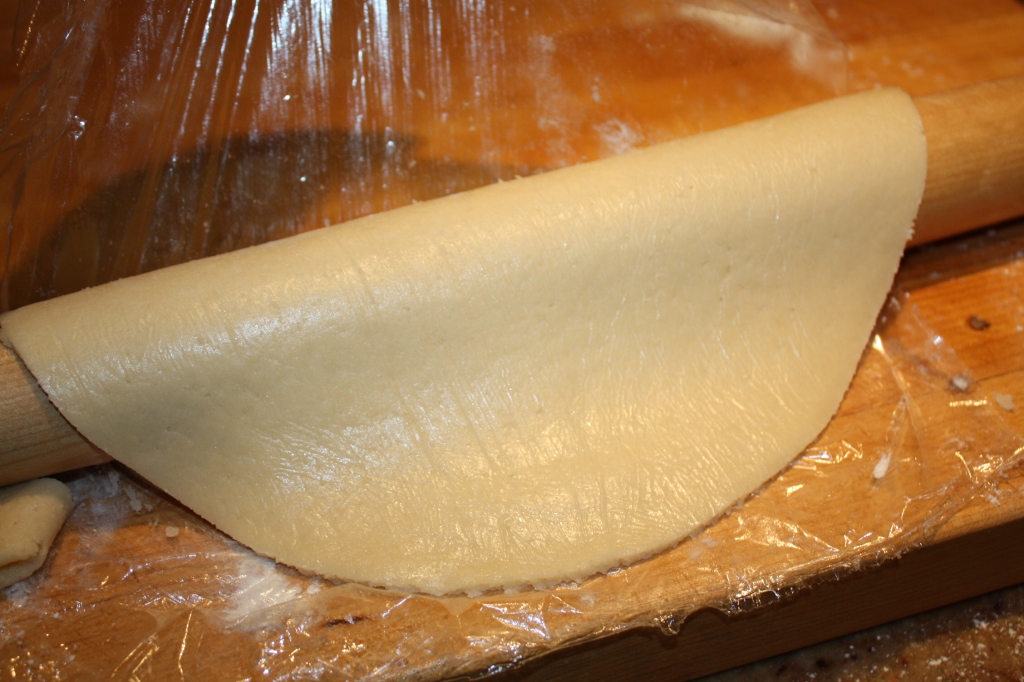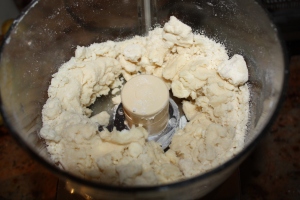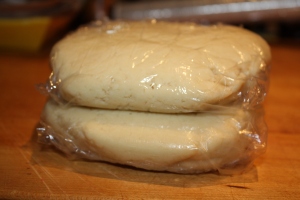This sweet pie dough recipe is the best I have found so far. Relatively easy to make, consistent results and so good!!!!!!! I have been reading Cook’s Illustrated magazine for many years. I find this magazine’s detailed recipes, tips and experiments full of valuable information as well as fun. If you haven’t had the chance to experience this magazine I invite you to do so. This is where America’s Test Kitchen, located just outside of Boston, “play” with recipes in a lab-kitchen and then publish the results (they also have a TV show hosted by Christopher Kimball). Its findings are illustrated (either with pictures or drawings) and provides its readers with bits of history, chemistry, culture and valuable suggestions. After many trials and errors, I bumped into this recipe while reading one of Cook’s Illustrated editions about 2 years ago, which I have only altered by adding a bit more sugar. I mainly use it for Blueberry Pie, but can also be filled with your choice of ingredients. Sometimes I have left overs from the trimmings of the pie discs and use it to make a small oven empanada filled with spinach and feta cheese, picadillo, stewed chicken, shrimps or sauteed mushrooms with onions and cheese, mixing sweet and savory in every bite. Also, can be used to cover a fruit cobbler.
The tricky thing with baking and doughs is the fact that you NEED to know a little about chemistry. The effects baking powder will have when reacting with liquids or the gluten formed when flour is mixed with water, all have to do with scientific reactions. Your ability to know when, how much, at what temperature and in what way to incorporate ingredients will determine how successful you will be in your culinary endeavors. That being said, with this pie dough recipe, Cooks Illustrated “kitchen scientists” tried making many pie recipes with varying results (148 to be exact!!!). Some were too hard, others too flaky, others too sandy, others just too inconsistent. For your information, gluten, long chains of protein that form when flour mixes with water, is what gives pie dough its structure. The more you knead and the more water you add, the more gluten forms and the result is a tough pie dough. The recipes I had seen before, mostly keep a ratio of about 5-6 tbsp of ice water to every 2 cups of flour to ensure flakiness, but with inconsistent results which depended on that days humidity among other factors (too dry, too hard, difficult to roll out, dough sticks or tears, etc.) In short, they discovered that vodka lets you add more liquid to the dough (making it easier to roll out) without toughening the crust. The simple reason is because gluten doesn’t form in ethanol (vodka is 60% water 40% ethanol). As a result, this recipe gets the benefits of 8 tbsp of water but actually has 6 1/2, which limits the formation of gluten and guarantees tenderness. The same reasons account for incorporating vegetable shortening in the recipe. Butter has about 20% water content and starts melting at 50ºF, as opposed to vegetable shortening which has no water and melts at very high temperatures, so a combination of both butter and shortening provided a balance between flavor and tenderness. In addition, flour is separated into two groups; the flour which will be covered with fat (which in turn will not absorb water), and the uncoated flour (which will absorb water and form gluten). For a consistent flaky recipe, you need the same ratio of fat coated flour to uncoated flour to ensure that when the dough is rolled out, the gluten stretches into sheets that are separated by gaps of fat which will melt while being baked and result in crisp, flaky layers in the crust. The best way to do this is in a food processor.
There are 3 steps to ensure a delicious, tender, flaky sweet pie dough.
1. Blend part of the flour mixture with the fats (butter and vegetable shortening) to make sure there is a consistent amount of flour covered in fat in the final dough. Fats should be cold.
2. Add remaining flour and pulse to ensure consistent amount of uncoated flour in final dough.
3. Sprinkle mixture with water and vodka and fold mixture until dough sticks together.
Note: You can feed this sweet pie dough to children because the alcohol will impart no flavor and evaporate in the oven.
Sweet Pie Dough
Ingredients
2 1/2 cups unbleached all-purpose flour, plus extra for work surface
1 tsp salt
3 tbsp sugar
1 1/2 sticks (12 tbsp) cold unsalted butter, cut into 1/4 inch slices
1/2 cup of cold vegetable shortening cut into 4 pieces
1/4 cup of cold vodka
1/4 cup of cold water
Procedure
1. In a food processor, mix 1 1/2 cups of flour, salt and sugar by pulsing two or three times. Add butter and shortening and process until there is no uncoated flour and forms cottage-cheese-like curds (about 15-20 seconds).
2. Scrape bowl with spatula and redistribute dough evenly around blade. Add remaining flour and pulse until dough is evenly distributed around bowl and mass has broken up (4-6 pulses). Empty mixture into bowl.
3. Sprinkle with vodka and water over mixture and quickly fold with rubber spatula by pressing down until dough is slightly tacky and sticks together.
4. Divide dough into 2 balls and flatten into disks. Wrap into plastic paper and refrigerate at least 45 minutes or up to 2 days.
5. When ready to roll out, sprinkle surface generously with flour so that it does not stick to rolling pin. Add flour as necessary.
















Wow, Aleida, fascinating recipe! I’ve never seen a pie dough with vodka in it before! But what you say makes great sense. Thank you..
yes celia, i know it sounds strange, but the result is amazing. soon will post recipe for best blueberry pie ever which includes this pie dough and its out of this world. delicious! wish it could work as and avocado pie….ja, ja! inside joke! could be great with any other fruit in season in australia. let me know if you give it a try…its worth it.